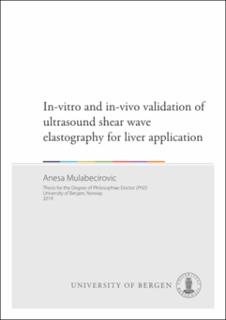In-vitro and in-vivo validation of ultrasound shear wave elastography for liver application
Doctoral thesis

Åpne
Permanent lenke
https://hdl.handle.net/1956/21448Utgivelsesdato
2019-11-28Metadata
Vis full innførselSamlinger
Sammendrag
Background and aims: Ultrasound (US) elastography is a noninvasive method that is used to investigate tissue elasticity in several organs. In chronic liver disease, the predominant approach is quantitative. By measuring liver stiffness, one could possibly follow the development of fibrosis in in chronic liver diseases. The spectrum of US elastography methods has been expanding, however, there is limited validation of several of the new methods. Validation is needed for the methods to be established as tools in clinical practice. The overall aim of this theses was to validate several US shear wave elastography (SWE) methods, including point shear wave elastography (pSWE) and 2D-SWE, in vitro and in vivo aiming at liver as the primary organ. In the first study the main aim was to assess and validate the repeatability, reproducibility and interobserver agreement of several US SWE methods. This was approached in vitro using liver fibrosis phantoms with known Youngs modulus. In the second and third study we assessed in vivo; in livers of an adult healthy cohort and a cohort of patients with primary sclerosing cholangitis (PSC). Furthermore, we aimed to define normal liver elasticity, assess number of repeated measurements needed to achieve a representative median value and explore the assessment of fibrosis. Methods: Methods to estimate tissue elasticity are usually integrated in US scanners. In the first study we used transient elastography (TE) and methods integrated in GE Logiq E9 (2D-SWE), Hitachi Ascendus (pSWE), Philips iU22 (pSWE) and Samsung RS80A with prestige (pSWE). Two investigators performed non-continued measurements in parallel on four individual tissue-mimicking liver fibrosis phantoms. In the second study we obtained liver stiffness measurements (LSM) in a healthy cohort of 50 men and 50 women using TE and methods integrated in GE Logiq E9 (2D-SWE) and Samsung TS80A (pSWE). Prior to the LSM all 100 subjects underwent lab tests and US examination in B-mode. Inter- and intraobservation between two examiners were assessed in a subgroup of 24 subjects. In the third study we used the pSWE method integrated in Philips iU22 and included 55 non-transplant PSC patients and 24 matched controls. All subjects underwent US examination and lab tests were performed on patients with PSC. We evaluated inter- and intraobserver variability of the spleen and liver elasticity measurements between two examiners in 19 healthy subjects. Main results: In the first study we found that all four US SWE methods could differentiate the four individual liver fibrosis phantoms. The methods had high repeatability and reproducibility. The inter-and intraobserver agreement was excellent and there was no significant difference in mean elasticity for all the US SWE methods. Furthermore, the study demonstrated that the difference in elastography measurements acquired with US SWE was larger for the harder phantoms with higher Youngs modulus compared to the softer ones. In the second study we found that the reproducibility and repeatability of LSM in healthy livers was high, furthermore, our results showed that the mean liver elasticity in a healthy adult cohort was higher when acquired with the 2D-SWE method, than with non-imaging SWE methods such as Samsung pSWE or TE. We also found that males had higher liver elasticity than females. In addition, we demonstrated that five consecutive acquisitions may be sufficient for reliable LSM results. In the third study, we found good intra- and interobservation agreement assessing Philips iU22 pSWE measurements of the right liver lobe in the healthy subjects. We also found that the PSC patients had higher LSM than the healthy controls when measuring the right liver lobe, whereas the LSM of the left liver and spleen elasticity measurements were indifferent between PSC patients and healthy controls. Conclusions: US SWE methods used in our studies demonstrated excellent in vitro and good in vivo repeatability and interobserver agreement. Mean LSM in our healthy cohort was significantly higher when obtained with 2D-SWE, and in male participants. We found no difference across age groups 20-70 years or among non-obese BMI-groups 18-30 kg/m2. Our results indicated that five LSM may be sufficient to obtain a reliable result in healthy livers. Furthermore, we showed that PSC patients displayed higher levels of LSM compared to the healthy controls. However, the range of LSM of PSC patients was wide, which could suggest increasing stages of fibrosis through the disease development, making SWE a possible method for prospective studies evaluating SWE as a prognostic tool.
Består av
Paper I: Mulabecirovic A., Mjelle A. B., Vesterhus M., Gilja O. H., Havre R. F. Repeatability of shear wave elastography in liver fibrosis phantoms – evaluation of five different systems, PLoS One 2018, 13(1): e0189671. The article is available in the main thesis. The article is also available at: https://doi.org/10.1371/journal.pone.0189671Paper II: Mulabecirovic A., Mjelle A. B., Vesterhus M., Gilja O. H., Havre R. F. Liver elasticity in healthy individuals by two novel shear-wave elastography systems - comparison by age, gender, BMI and number of measurements, PLoS One 2018, 13(9): e0203486. The article is available in the main thesis. The article is also available at: https://doi.org/10.1371/journal.pone.0203486
Paper III: Mjelle A. B., Mulabecirovic A. Hausken T., Havre R. F., Gilja O. H., Vesterhus M. Ultrasound and point shear- wave elastography in livers of patients with primary sclerosing cholangitis, Ultrasound in Medicine and Biology 2016, 42(9): 2146–2155. The article is available in the main thesis. The article is also available at: http://dx.doi.org/10.1016/j.ultrasmedbio.2016.04.016